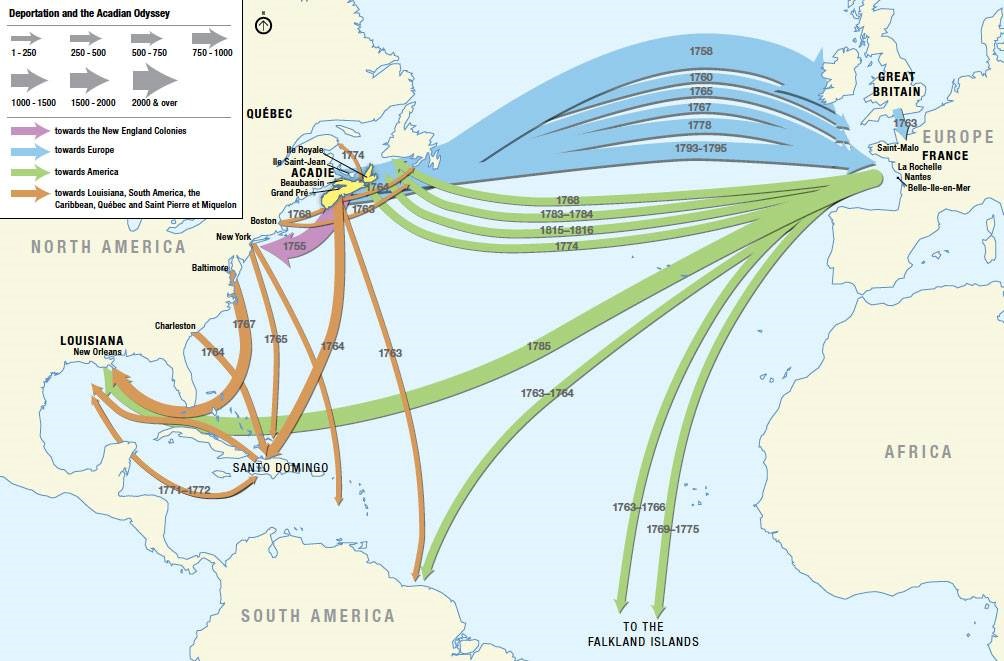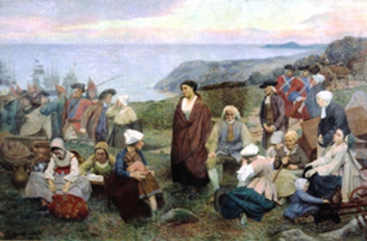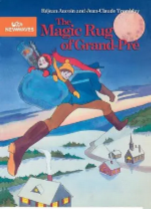Grades 3 - 4
 Port-Royal Habitation : A doorway to the past = L'Habitation de Port-Royal : Le portail magigue by
Port-Royal Habitation : A doorway to the past = L'Habitation de Port-Royal : Le portail magigue by Includes: Excerpt of Samuel de Champlain’s journal; Illustration of L’Habitation on St. Croix Island; Video DVD “Port Royal Habitation” A Doorway to the Past English/French.
Muskrat Will Be Swimming by
The Language and Literacy Unit for the book, Muskrat Will Be Swimming is tailored to Native American preschoolers. This unit uses a Native American creation story to address the various domains of language (phonology, morphology, semantics, syntax, and pragmatics) and pre-literacy skills (alphabet, letter-sound correspondence, sight words, vocabulary, early phonics, question structures, and pre-writing) in daily activities and collaborative projects. These incorporate culturally-responsive teaching strategies.
Grades 5 - 6
 Acadian story : We are here to stay by A modern story based on young girl talking to her grandparents. Includes a study guide for every chapter
Acadian story : We are here to stay by A modern story based on young girl talking to her grandparents. Includes a study guide for every chapterEvangeline : a tale of Acadie by
This lesson plan uses the poem Evangeline: A Tale of Acadie and Evangeline’s ABC
Prerequisite to activity: History of Acadia and Expulsion; Acadian Diaspora
 The Acadian Dikes : An Interdisciplinary Study of Technology by Students will learn the technology behind the 400-yr old system of drying salt marshes to create arable farming land.
The Acadian Dikes : An Interdisciplinary Study of Technology by Students will learn the technology behind the 400-yr old system of drying salt marshes to create arable farming land. Acadian diaspora lesson plan by
Acadian diaspora lesson plan by Student will learn the major factors leading to the Deportation of Acadians; understand the difficulties, injustices, and conditions faced by the Acadians after the Grand Dérangement 1755 – 1763; connect the Acadian Diaspora to modern representations of forced migration; recognize the terms Acadian, diaspora, refugee, allegiance, community, assimilate.
Grades 7 - 8
The Diary of Marie Landry, Acadian Exile by
Based on the book by Stacy Demoran Albritton. Summary: In-depth analysis of story line and context (history of Acadia, their Deportation, and how some of the Acadians migrated to Louisiana).
Dead reckoning: Champlain in America by
12 lesson plans for Grades 6 – 12 on the website: http://www.champlaininamerica.org/ Evangeline : a tale of Acadia by
Evangeline : a tale of Acadia by Students will research a variety of primary and secondary sources to write an editorial. The editorial will first explain the main points of Lt. Governor Lawrence’s Deportation Orders. Second, the editorial will present a point of view with support concerning the removal of the Acadians.
 Leaving home: Migration into and out of Atlantic Canada by
Leaving home: Migration into and out of Atlantic Canada by Students will examine factors that attracted settlers to and forced them away from Acadia in two historical periods. After examining these factors, students will draw conclusions about the cultural impact of these migrations upon the people. Knowledge about these movements should reinforce empathy for these “real” people and allow comparisons with more recent migrations.
http://canadiangeographic.ca/atlasWinds of l'Acadie by
Sarah, a 16-year old from the city of Toronto, spends the summer with her grandparents in Wolfville, Nova Scotia. Sarah travels through time to the Deportation era.
Teacher’s guide includes historical background.
http://www.culturecopse.com/Winds%20of%20L'Acadie%20-%20Teachers%20Guide.pdf Acadie Liberte
Acadie LiberteStudents will watch the video Acadie Liberté that describes the Canadian settlements in the Atlantic region of Canada. The students will know the different motives and background for the Acadian expulsion.
Grades 1 to High School
 Wolastoqiyik and Mikmaq studies lesson plan
Wolastoqiyik and Mikmaq studies lesson planThe Acculturation of Curriculum project of the province of New Brunswick and Aboriginal Affairs and Northern Development Canada.
Elementary level:
Students will adopt a terminology of harmony and respect for classroom discussions regarding Maliseet and Mi’kmaq people; learn about these tribes’ people, culture, languages, traditions, geography, and origins. Activities of the 2014 Acadian World Congress by
Activities of the 2014 Acadian World Congress by A 37-page pedagogical activities booklet exploring the Congrès mondial acadien 2014 and its hosting region “Acadia of the Lands and Forests”. This territory consists of northwestern New Brunswick, Témiscouata County in Québec, and the upper St. John Valley in Maine, or the historical Madawaska Territory. It is a companion to the teaching manual “Acadia of the Lands and Forests…host of the Congrès mondial acadien 2014”.
A sampling of themes/activities:
The story of Tante Blanche
The festival “Foire Brayonne”
The monster “Poné” of Lake Pohénégamook
The legend of Malobiannah
Fort Ingall
The legend of Billy Fly
Examining the term “cultural identity”
Exploring the map of Acadia of the Lands and Forests
Exploring the concept of living on an international border
Exploring the concept of human diaspora: Jews, Acadians
Exploring the difference between genocide and ethnic cleansing
Some traditions that have survived time and distance: Mardi Gras, foods
High School
 Evangeline le grand derangement and cultural survival by
Evangeline le grand derangement and cultural survival by This lesson plan will introduce students to the history of the forced removal of thousands of people from Acadie; the romantic look back at the tragedy in Henry Wadsworth Longfellow’s famous epic poem Evangline and how the titular heroine has been received by Acadian and non-Acadian readers over time as well by Maine’s Acadian community today; including relations with Acadian communities in new Brunswick and throughout the Acadian Diaspora. Students will read and discuss primary documents, compare and contrast Le Grand Dérangement to other forced expulsions in Maine history, and discuss the significance of cultural survival amidst hardships brought on by treaties, wars, imperialism, colonialism, and legislation.
 La complainte d'Abraham Gagnon by
La complainte d'Abraham Gagnon by Based on an original song written in French about two brothers who died within three months of each other in 1907.
Students will listen to and read the original song (complainte) by Abraham Gagnon, learning about the forest industry in northern Maine. Students will develop a sense of how traditional music has a unique and distinctive social function.

